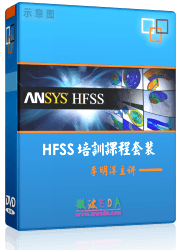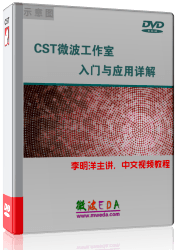Special Frequency Domain Solver Parameters
 Simulation:
Solver Simulation:
Solver  Start Simulation Start Simulation  Frequency Domain Solver Frequency Domain Solver  Specials Specials
Linear solver frame
Solver type:
This option allows you to specify whether an iterative
or a direct linear equation system
solver should be used. In general, the direct solver is recommended for
relatively small problems with multiple excitations. The iterative solver
is advantageous for large problems. As a default, the frequency domain
solver automatically chooses the solver type.
Use
Helmholtz Equation: This option is available for the general
purpose frequency domain solver with hexahedral mesh only. If activated,
the Helmholtz equation is used when running the solver. This usually leads
to a faster convergence of the solver, especially for low-frequency problems.
Low
frequency stabilization: This option is available for the general
purpose frequency domain solver with tetrahedral mesh only. If activated,
it may lead to a faster convergence of the solver for low frequency problems.
Use
accelerated recalculation: If activated, the general purpose
frequency domain solvers store a subset of the results from frequency
samples calculated so far to reuse this information for an accelerated
recalculation of additional frequency samples in subsequent solver runs.
Because a direct equation system solver does not profit from a good initial
guess of the solution, this mainly applies to the iterative solver. However,
you may try to calculate some frequency samples using the direct solver
and continue with the iterative solver, thereby taking into account solutions
from the direct solver to speed up the simulation.
Use
new iterative solver: This option is available for the general
purpose frequency domain solver with hexahedral mesh only. It is recommended
to use the new iterative solver unless convergence problems are encountered.
Maximum number
of iterations: Iterative solvers can be forced to terminate after
the given number of iterations by enabling this option.
Solver order frame:
Allows to specify whether the general purpose
frequency domain solver with tetrahedral mesh uses a first, second, or
third order method. Second order is the default. If the structure is geometrically
complex, first-order is an alternative. Higher order allows to achieve
accurate results with less mesh cells and eventually less memory consumption
than lower order, if the structure contains electrically large voids rather
than many geometric details. For a given mesh resolution, higher order
will provide even more accurate results.
Whenever the solver order is changed, for instance
from second to first order, the resolution of the initial mesh and some
parameters in the adaptive mesh refinement dialog should be adapted. These
settings can be applied automatically. For a change back to a previously
active order, the corresponding settings can be restored. A query will
be displayed in either case. Furthermore, if a higher order is selected,
some mesh and solver settings may be relaxed, if only a comparable level
of accuracy is required. A prompt will ask if relaxed defaults for higher
should be applied. Answer no only if you wish to increase the solver's
accuracy by using higher order.
Variable:
If this option is activated, the general purpose frequency domain solver
with tetrahedral mesh is allowed to use variable order for each tetrahedron,
rather than constant order throughout the calculation domain. The solver
order's upper limit is then given by the order selected in the drop down
combo box right above the Variable
check box. Enable this option if the structure contains electrically small
details as well as large voids. The solver then will assign an initial
distribution of the solver order to the tetrahedrons, which eventually
is changed in the course of the adaptive mesh refinement.
Curvature...
It is recommended to increase the curved element order, which is a property
of the mesh, if the solver order is increased. The button directly opens
the special tetrahedral
mesh properties where the Curved
element order can be changed.
Materials frame
Activate the check button Fit
as in Time Domain to consider the fit procedure of the tangent
delta settings in the Material
Parameter Conductivity Dialog using a dispersive Debye model correspondent
to the time domain. A general or conductivity dispersion fit of tabulated
data will also be considered as in the time domain solver. With this button
deactivated, the constant fit option is realized as a constant tangent
delta over the complete frequency range while a dispersive fit results
in a linear interpolation between the defined loss angle values. Likewise,
all other tabulated material properties are linearly interpolated.
The setting affects also the treatment of broadband
surface impedance materials, i.e. ohmic sheet, tabulated surface impedance
and corrugated wall (see the Material
Overview for details). With this button activated the simulated surface
impedance will be computed accordingly to the same fitting scheme used
for the time domain solver. Otherwise a linear interpolation scheme of
the data will be applied.
The setting also affects the treatment of dispersive
materials if the model
simplification is configured so that lossy materials are treated as
lossfree.
Calculate static
H-field for Ferrites allows to use an inhomogeneous static biasing
H-field for ferrites. Set up a single project with material definitions
and sources for the low and high frequency simulation. The static field
is calculated automatically by the magnetostatic solver before the frequency
domain solver run. This is supported by the frequency domain solver with
tetrahedral mesh. See the Material
Overview for details. An example can be found here: Biased
Circulator.
Activate the check button Calculate
power loss to include into the 1D Results tree folder information
concerning the losses over materials. Both volume and surface losses will
be extracted. Enable Store per solid
to include a subfolder sorting losses by solids.
Open boundaries frame
The solver's realization of the open boundary
can be chosen from the drop down box. Solver
default is the recommended setting. Open boundaries for unit cells
are implemented as a Floquet mode port, which is not listed here. For
the usual open boundaries however, either simulation speed and low memory
consumption (SIBC), or the low
artificial reflection of the perfectly matched layer (PML)
can be favoured.
With tetrahedral mesh, the default is the standard
impedance boundary condition (SIBC.) It shows low artificial reflection
for plane waves that impinge on the open boundary perpendicularly (the
field solution of course is not necessarily a plane wave, but might be
considered as the superposition of various plane waves at different angles.)
For "plane wave" angles closer to grazing incidence, the PML
provides lower artificial reflection, but at the cost of higher memory
usage and more demanding linear equation systems, which require more time
to solve.
With hexahedral mesh, the open boundaries are
usually realized with a PML, but a free space SIBC, which is valid for
vacuum background material may be chosen as a low-memory or low-frequency
alternative.
The check button Add
space before mesh generation increases the distance to the SIBC open boundaries beyond the visible
bounding box of the structure (tetrahedral mesh only.) It is recommended
to enable this option or to choose PML
if farfield monitors have been defined. For weakly radiating and electrically
small structures this additional space might not be necessary. If the
option is off, please add space manually to ensure that the open boundary
is not too close to the structure.
Waveguides frame
Activate the check button Electric
shielding for all ports to let the boundary of all waveguide ports
be treated as a perfectly shielding (PEC) wire frame.
The check button Ignore
losses can be enabled to simplify the port mode calculation: all
lossy materials and boundary conditions for waveguide ports will be treated
as loss-free during the port mode calculation. This flag can be used independently
of the treatment of lossy materials in the 3D solver run.
The option Port
mesh and 3D mesh match only applies to the tetrahedral mesh and
is disabled by default. The waveguide port mode solver operates on the
planar mesh of the waveguide port and applies an adaptive port mesh refinement
for this mesh. By default, the port mesh is separated from the volumetric
mesh, and an overlap calculation is used to map the port mode solution
onto the boundary of the volumetric mesh. However, if you enable Port mesh and 3D mesh match, the port
mode solver's mesh adaptation directly refines the surface mesh of the
3D mesh, so that no overlap calculation is required. It is recommended
to let port mesh and 3D mesh match whenever the overlap calculation fails
due to geometric tolerance problems.
OK
Accepts the input and closes
the dialog.
Cancel
Closes this dialog box without
performing any further action.
Help
Shows this help text.
See also
Frequency
Domain Solver Parameters, Which
Solver to Use, Frequency
Domain Solver Overview




HFSS视频教程
ADS视频教程
CST视频教程
Ansoft Designer 中文教程
|